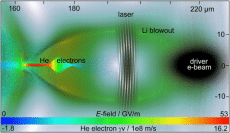Parallel Simulation of Electron Cooling Physics and Beam Transport
Key challenges
This project actually supports all electron cooling simulation activities of the accelerator SciDAC-2 project "ComPASS" that has been extended into 2013. The electron cooling team includes personnel from BNL, JLab, and Tech-X Corporation. The team has been "charged" by the Office of Science to make effective use of emerging petascale hardware to accurately simulate the performance of proposed electron cooling systems.
Why it matters
Electron cooling is used to shrink the size, divergence, and energy spread of a charged particle beam without removing particles from the beam. The purpose is to increase luminosity. Projects at NERSC support the Continuous Electron Beam Accelerator Facility (CEBAF) upgrade and various luminosity upgrade possibilites for the Relativistic Heavy Ion Collider (RHIC) at BNL. CEBAF is the main research accelerator at JLAB.
The Nuclear Physics program supports a broad range of activities aimed at research and development related to the science, engineering, and technology for accelerators of electrons, protons and heavy ions. A major focus in all of areas is superconducting radio frequency (RF) acceleration and its related technologies.
The present focus of parallel simulations at NERSC spans three technical areas:
- electron cooling of relativistic hadron beams (to increase luminosity);
- beam-beam collisions (determine effect on beam dynamics, luminosity);
- spin-tracking (understand how to keep polarized beam fraction high).
Coherent Electron Cooling uses a Free Electron Laser (FEL) to combine electron & stochastic cooling concepts. Many technical difficulties must be resolved via full-scale 3-D simulations before the CeC concept can be validated experimentally. There are three main code suites used in this work: VORPAL, BeamBeam3D, and UAL-SPINK.
Accomplishments
Vorpal was used for 3D- delta-f PIC simulations of anisotropic Debye shielding in a full longitudinal slice of the co-propagating electron beam, choosing parameters relevant to the proof-of-principle experiment under development at BNL. Parallel 3D simulations at NERSC show 3D effects for ions moving longitudinally and transversely. Near the edge of the beam, where the density is changing rapidly, delta-f PIC results show a weaker shielding response toward the edge of the beam compared with the constant-density theory for this phenomenon.
Investigators
D.L. Bruhwiler (University of Colorado), and others
More Information
"High-Fidelity 3D Modulator Simulations of Coherent Electron Cooling Systems," Proceedings of IPAC2012, New Orleans, Louisiana, USA








